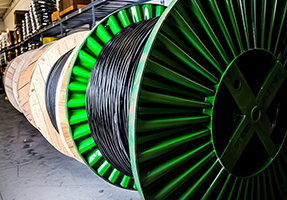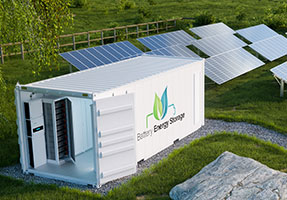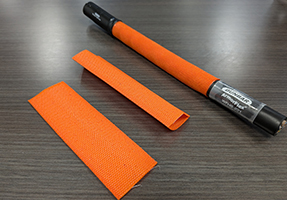Medium Voltage Cables for Efficient Power Distribution
- Kassie Teagarden
- Wire & Cable
- May 20, 2025
- 62views

Medium Voltage Cables for Efficient Power Distribution
Discover the essentials of medium voltage cables for efficient power distribution, including construction, insulation types, and applications for industrial use.
Medium voltage (MV) cables play a crucial role in modern power distribution, serving as the foundation of electrical systems in a variety of settings, including industrial facilities and residential areas. These cables, typically rated for operations between 5kV and 35kV, are crucial for transmitting electricity efficiently and reliably over moderate distances.
Let's explore essential characteristics, construction, and selection criteria for medium voltage cables, drawing insights from industry standards.
The Crucial Role of Medium Voltage Cables
Medium voltage cables bridge the gap between high voltage transmission lines and low voltage distribution networks, ensuring power reaches its final destination safely and effectively.
Their design includes specialized insulation to make them suitable for applications where higher power capacities and greater distances are involved, distinguishing them from their low voltage counterparts.
MV cables can be used in new plant constructions, industrial expansions, mining operations, and military installations, providing the necessary power infrastructure to keep these critical functions running.
The ability of MV cables to handle significant electrical loads with minimal energy loss makes them a cornerstone of industrial efficiency and urban development. Their durability and high performance make them the go-to choice for critical infrastructure projects where reliability is essential.
Key Attributes and Options for Medium Voltage Cables
Selecting the right medium voltage cable involves understanding a range of attributes, each contributing to the cable's performance, durability, and suitability for specific environments. Here's a breakdown of the key considerations, summarized in the table below:
Medium Voltage Cable Options and Selections
| Attribute | Options |
|---|---|
| Constructions |
CTS (Copper Tape Shield) Cable: Power distribution cable with a semi-conducting layer around the conductor and a helically applied copper tape shield. URD (Underground Residential Distribution) Cable / JCN (Jacketed Concentric Neutral) Cable: Electrical power distribution cable designed for underground supply (direct burial) applications. This cable has a central conductor, an insulating shield, a layer of concentric neutral wires, and an outer jacket. |
| Types |
MV-90 Cable: Rated for operation up to 194°F (90°C). MV-105 Cable: Rated for operation up to 221°F (105°C) and is often used in industrial applications with higher temperatures. |
| Insulation Types |
EPR (Ethylene Propylene Rubber): Offers excellent flexibility and moisture resistance, making it suitable for wet environments and installations requiring tight bends. XLPE (Cross-Linked Polyethylene): Known for its high dielectric strength and thermal stability, making it ideal for high-voltage applications and resistance to deformation under heat. TR-XLPE (Tree-Retardant Cross-Linked Polyethylene): Enhanced version of XLPE designed to resist "water treeing," a common cause of insulation breakdown in underground cables, thus extending cable life. |
| Insulation Coverage |
100% Coverage: Suitable for grounded systems where fault currents are cleared quickly by the protective devices. 133% Coverage: Used in ungrounded or impedance-grounded systems where fault currents may persist for a longer duration, requiring higher insulation integrity. |
| Voltages | 5kV, 15kV, 25kV, 35kV |
| Conductor Material |
Copper: Offers superior conductivity and strength, often preferred for its efficiency and durability. Aluminum: Lighter and more cost-effective than copper, widely used in many applications where weight and budget are considerations. |
| Jacket Material |
PVC (Polyvinyl Chloride): Provides good mechanical protection and flame retardancy, commonly used for general-purpose applications. CPE (Chlorinated Polyethylene): Offers excellent resistance to oil, chemicals, and abrasion, making it suitable for harsh industrial environments. |
Cable Constructions
The construction of a medium voltage cable indicates its application and performance characteristics. Two primary constructions are commonly available:
- CTS (Copper Tape Shield) Cable: This power distribution cable features a semi-conducting layer applied around the conductor, which is then covered by a helically wound copper tape shield. This design is highly effective in managing electrical stress and containing the electromagnetic field, which is critical for safe and efficient power transmission. The copper tape shield provides a uniform electric field distribution, minimizing partial discharges and extending the cable's lifespan. It's often chosen for its robust shielding capabilities in a variety of industrial and commercial settings.
- URD (Underground Residential Distribution) Cable / JCN (Jacketed Concentric Neutral) Cable: These terms are often used interchangeably to describe an electrical power distribution cable specifically engineered for direct burial applications, particularly in underground residential distribution systems. The URD/JCN cable structure includes a central conductor, an insulating shield, a layer of concentric neutral wires, and an outer jacket. The concentric neutral wires are strategically placed to provide a low-resistance path for fault currents and to help contain the electric field within the cable. This construction is vital for ensuring safety and reliability in subterranean installations where protection from environmental elements and mechanical damage is paramount.
Cable Types Based on Temperature Ratings
Medium voltage cables are also categorized by their maximum operating temperatures, which is a critical factor for industrial applications where ambient temperatures can fluctuate significantly.
- MV-90 Cable: This cable type is rated for continuous operation at temperatures up to 194°F (90°C). MV-90 cables are widely used in a variety of environments, offering a balance of performance and thermal resilience suitable for most standard industrial and utility applications.
- MV-105 Cable: Designed for more demanding conditions, MV-105 cables are rated for operation up to 221°F (105°C). Their enhanced thermal rating makes them particularly suitable for heavy industrial applications where higher temperatures are prevalent or where the cable might experience higher current loads leading to increased internal heat generation. The MV-105 rating ensures greater longevity and reliability in these challenging environments.
Insulation Materials: The Core of Cable Performance
The insulation material is arguably the most critical component of a medium voltage cable, as it prevents electrical current from leaking and ensures the safe transmission of power. Advances in polymer technology have led to several highly effective insulation options:
- EPR (Ethylene Propylene Rubber): Known for its exceptional flexibility, EPR insulation allows for easier installation, especially in conduits or tight spaces where bending is required. It also offers excellent moisture resistance, making EPR cables a reliable choice for wet or submerged environments. Its high resistance to ozone and corona discharge contributes to its long-term stability and performance.
- XLPE (Cross-Linked Polyethylene): This insulation material is highly favored for its superior dielectric strength and thermal stability. XLPE cables can withstand high electrical stresses and maintain their structural integrity even under elevated temperatures, making them ideal for high-voltage applications. Its cross-linked molecular structure provides excellent resistance to deformation under heat and improves its overall mechanical toughness.
- TR-XLPE (Tree-Retardant Cross-Linked Polyethylene): An advanced variant of XLPE, TR-XLPE is specifically engineered to combat "water treeing," a phenomenon where microscopic water-filled channels form within the insulation, leading to premature breakdown. By inhibiting the growth of these "trees," TR-XLPE significantly extends the operational life of underground cables, offering enhanced reliability and reducing maintenance costs over time. This makes it particularly valuable for direct burial and other subterranean installations.
Insulation Coverage: Ensuring System Integrity
Insulation coverage levels are selected based on the grounding system of the electrical network, directly impacting the cable's ability to handle fault conditions.
- 100% Coverage: This level of insulation coverage is suitable for grounded systems. In such systems, if a fault occurs, the fault current is quickly detected and cleared by protective devices, minimizing the duration of electrical stress on the cable. This coverage offers adequate protection where rapid fault clearance is guaranteed.
- 133% Coverage: Employed in ungrounded or impedance-grounded systems, 133% insulation coverage provides a higher margin of safety. In these systems, fault currents may persist for a longer duration before being cleared, requiring insulation to withstand prolonged electrical stress. The increased insulation thickness ensures greater integrity and reliability under these more demanding fault conditions.
Insulation Coverage: Ensuring System Integrity
Insulation coverage levels are selected based on the grounding system of the electrical network, directly impacting the cable's ability to handle fault conditions.
- 100% Coverage: This level of insulation coverage is suitable for grounded systems. In such systems, if a fault occurs, the fault current is quickly detected and cleared by protective devices, minimizing the duration of electrical stress on the cable. This coverage offers adequate protection where rapid fault clearance is guaranteed.
- 133% Coverage: Employed in ungrounded or impedance-grounded systems, 133% insulation coverage provides a higher margin of safety. In these systems, fault currents may persist for a longer duration before being cleared, requiring insulation to withstand prolonged electrical stress. The increased insulation thickness ensures greater integrity and reliability under these more demanding fault conditions.
Conductor and Jacket Materials: Balancing Performance and Protection
The choice of conductor and jacket materials is vital for the cable's electrical efficiency, mechanical protection, and environmental resilience.
Conductor Material
- Copper: Renowned for its superior electrical conductivity and inherent strength, copper is often the preferred conductor material. It offers excellent current-carrying capacity, minimal power loss, and high durability, contributing to the overall efficiency and longevity of the cable system.
- Aluminum: A lighter and more cost-effective alternative to copper, aluminum conductors are widely used in applications where weight considerations and budget constraints are significant factors. While it has lower conductivity than copper, advancements in aluminum alloy technology have made it a viable and efficient choice for many medium voltage applications.
Jacket Material
PVC (Polyvinyl Chloride): A common jacket material, PVC offers good mechanical protection against abrasion and impact. It also provides inherent flame retardancy, making it suitable for general-purpose applications in various industrial and commercial settings where fire safety is a concern.
CPE (Chlorinated Polyethylene): For harsher industrial environments, CPE jackets are often preferred. CPE offers excellent resistance to oils, chemicals, and abrasion, providing superior protection against corrosive substances and mechanical wear. Ideal for applications in factories, chemical plants, and other areas where the cable might be exposed to aggressive conditions.
Applications of Medium Voltage Cables
The versatility and reliability of medium voltage cables make them indispensable across a broad spectrum of industries and applications. They are critical for:
- Industrial Plants: Providing power to heavy machinery, motors, and lighting systems in manufacturing facilities, ensuring continuous operation.
- Mines and Quarries: Withstanding harsh environmental conditions, including moisture, abrasion, and temperature extremes, to deliver power for extraction equipment.
- Military Bases: Supplying reliable power for critical infrastructure, communications systems, and various operational needs, often in demanding conditions.
- Utility Distribution: Forming part of the electrical grid, especially in underground and overhead distribution lines for residential and commercial areas.
- Renewable Energy Projects: Connecting wind turbines and solar farms to the grid, handling the generated power efficiently.
- Commercial Buildings: Powering large office complexes, shopping centers, and data centers, ensuring a stable and secure power supply.
Medium Voltage Cable at LAPP Tannehill
Medium voltage cables are fundamental components of electrical infrastructure, enabling the efficient and safe distribution of power across various sectors. Understanding their diverse constructions, insulation types, coverage options, and material choices is helpful for selecting the appropriate cable for any given application.
By carefully considering factors such as operating temperature, environmental conditions, and system grounding, Engineers and Project Managers can ensure the longevity, reliability, and optimal performance of their electrical systems.
LAPP Tannehill offers a comprehensive range of MV-90 and MV-105 cables, along with various conductor and jacket materials, to meet the specific demands of industrial power distribution and other critical applications.






